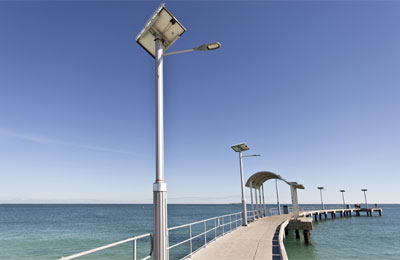
Image: Bigstockphoto. For illustration purpose only
Bahrain tests solar-powered street lighting
MANAMA, September 21, 2014
Bahrain’s Electricity and Water Authority (EWA) is currently monitoring a test phase, involving 20 solar panel-equipped lights to evaluate the project's feasibility, a report said.
Designed to operate independently from each other and the national power grid, each streetlight is a stand-alone unit that derives its power entirely from the sun, reported the Gulf Daily News (GDN), our sister publication.
'With regard to the lights, they fall under the category of energy-efficient applications and we pay special attention to this area,' an EWA spokesman told the GDN.
'In particular, we are looking at solar-powered lights with enhanced energy efficiency through the use of LED bulbs.'
Commissioned in September last year, the Hidd pilot project only covers a stretch of road less than half a kilometre in length '“ but it has already been beset with problems due to the high levels of maintenance that the solar panels require.
'Maintenance may be the most important factor that contributes to the maximisation of individual streetlight performance,' said the spokesman.
'The output of each panel is very much related to its effective cleaning and maintenance as well as the angle of the sun, the intensity of sunlight it receives, the current level of cloud cover and the temperature.
'Light intensity is lower in the winter months than during the summer, as the sun moves from its highest point in the sky at the beginning of the summer to its lowest point at the beginning of winter.'
To maximise the effectiveness of the panels, they constantly have to be readjusted throughout the year to counter these environmental changes, the spokesman said.
Bahrain has more than 100,000 street lights, either wall or pole-mounted, which consume the equivalent of 110 gigawatts of electricity per hour of use, according to the EWA.
The Hidd pilot project is part of the authority's efforts to replace these grid-powered lights with a more energy-efficient, reliable system that will work even under the worst local weather conditions.
Technology
'Solar street lighting is feasible in Bahrain because the country enjoys a high level of solar irradiance throughout the year, reaching more than 2,000 kilowatt-hour per square metre,' said the spokesman.
'Technology is maturing and the market for the main components of solar-powered systems, particularly the panels, controllers and storage batteries, is getting more competitive globally as well as regionally.
'The price of components is dropping, making it easier to justify the use of such systems economically.
'Moreover, there has been a tremendous advance in LED light technology in terms of quality and compatibility for street lighting.'
Once the pilot project is complete, a viability assessment will be carried out to determine whether the solar-powered lights can be used throughout the country, although no estimate was available for when this might be.
The GDN reported in December last year that authorities were being urged by the Southern Municipal Council to fast-track plans to implement solar-powered streetlighting across Bahrain.
Awali, Bahrain University and the Bapco Refinery already benefit from a related project, which features streetlights that are not connected to the traditional power grid and run on solar panels installed by US firm Petra Solar. – TradeArabia News Service







